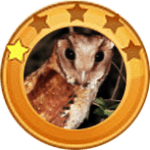- Home
- Shop
- Forest Series
- Grassland Series
- Desert Series
- Contact
- Home
- Shop
- Forest Series
- Grassland Series
- Desert Series
- Contact

Bay-Owl Series





Two Control Modes
1. Parental Remote-Control Mode: You can enjoy fun with your children together. 2. Battery Operate Mode: Your children can easily start the ride car with the push of a button and control it to move forward or backward.
Kid-Friendly Designs
a. Soft start design prevents your kids from being scared by sudden acceleration. b. The retractable handle and wheels make the toy car easy to move when it is not running. c. It comes with and spacious seat with safety belt.
Best Gift for Children
Our kid ride on car with cool licensed Mercedes-Benz appearance, is an exquisite gift for children aged 3 to 8 years old. It measures 39.4” (L) X 22.8” (W) X 18.1” (H) and weighs 22.4 lbs. Maximum weight capacity: 66 lbs. Charging time: 8 to 12 hours.


CHARACTERISTICS
The Chipmunk is a member of the family Mammalia, Rodentia and Sciuridae. It is also known as the Striped Squirrel, the Timber Tiger and the Mini-bear. The body length among most Chipmunks ranges from 5.5 to 6.3 inches and the tail length is 5 Inches. Chipmunks typically weigh about 0.02 pounds and live about 5 to 10 years. They have small but prominent ears which face forwards, and small eyes on the sides of their heads. Most wild Chipmunks are lively.


Lorem ipsum dolor sit amet, consectetur adipiscing elit. Ut elit tellus, luctus nec ullamcorper mattis, pulvinar dapibus leo.


CHARACTERISTICS
The Oriental Bay-Owl is a small bird that measures 8.9-11.4 inches long and weighs 0.56-0.68 pounds. Females are often larger than the males of this species. The top and back halves of their bodies are a deep chestnut color, while the bottom of their bodies as well as their stomach are a cream and tarnish color. The Oriental Bay-Owl has large, striking black eyes, which are highlighted due to the color contrast of their faces.

RANGE AND HABITAT
The Oriental Bay-Owl is typically found and distributed throughout Nepal, Sikkim, Assam, Nagaland, Manipur, Burma, and Thailand, east to south China, and south through the Malay Peninsula to the Greater Sundas. They are most comfortable living in woodlands, plantations, and mangrove swamps at altitudes of up to 7,220 feet, leading to their being scattered around India, Thailand, Singapore, the Philippines, and other parts of Southeast Asia.

DIET
The Oriental Bay-Owls prey upon small rodents, bats, birds, snakes, frogs, lizards, magpies, and large arthropods such as beetles, grasshoppers, and spiders. Because of their short and rounded wings, they can hunt more easily, especially near water. Southeast Asia’s humid and tropical climate provides the species with an abundance of food and trees to hunt from. The owl feeds its young an assortment of rodents, lizards, and frogs when caring for them.

BEHAVIOR
Habits and Lifestyle
The Oriental Bay-Owl tends to be nocturnal and stays to itself. It is very little known, even in its area of origin. Being that they are small and typically stand upright, they are very difficult to spot as they find comfort in their vast range of habitats. Their ability to resonate is remarkable, for they not only hoot but also scream and create high-pitched whistle songs. Their songs typically consist of four to seven melancholic whistles, lasting anywhere between two and eight seconds, and the pitch slightly increases towards the end. They sometimes alternate with a shorter whistle that goes “kleet-kleet-kleet” or “kleek-kleek-kleek” when moving between places.
Mating Habits
Breeding time is usually in the months of March, April, and May. The eggs tend to be laid between March and July. They tend to nest in hollowed-out tree trunks as well as any other hole they can find. At a time, around 3-5 eggs are laid; the appearance of the eggs is white and rather small. Both the male and female of this species are concerned about their offspring. The mother incubates the egg starting at the 2 day mark. Incubation lasts for approximately 36-42 days, and there is usually a 100% survival rate for the zygote. The father is the one who hunts and brings nourishment back for the offspring.

The Chipmunk is a member of the family Mammalia, Rodentia and Sciuridae. It is also known as the Striped Squirrel, the Timber Tiger and the Mini-bear. The body length among most Chipmunks ranges from 5.5 to 6.3 inches and the tail length is 5 inches. Chipmunks typically weigh about 0.02 pounds and live about 5 to 10 years. They have small but prominent ears which face forwards, small eyes on the sides of their heads. Most wild Chipmunks are lively.
The Red Squirrel, a member of the Sciuridae, is an arboreal, omnivorous rodent often referred to as a Forest Seeder and folklore as the Devil King Squirrel.
The Arizona Gray Squirrel, also known as the American Gray Squirrel, is a member of the family Rodentia and Sciuridae. It is small in size, with gray fur and a belly between white and cream. It has long ears, no tufts of fur and a fluffy tail edged in white. The body is about 16-20 inches long and weighs up to 1.4 pounds.
The Rock Squirrel, also known as Sao Maozi or Stone Mouse, belongs to the rodent and is a species in the family Sciuridae. The most common natural predators of the Rock Squirrel include bobcats, owls, eagles and snakes. Though the Rock Squirrel is cute, alert, and courageous, it is still considered a pest due to its habit of destroying crops.
The Abert’s Squirrel is a member of the genus Sciurus with a body length of 18-22.8 inches, a tail length of 7.5-9.8 inches and a weight of 2.2 pounds, and can live up to 10 years in the wild. Its most distinctive feature is tassels of fur about 0.8-1.2 inches long at the tip of its ears, which looks very interesting. In addition, it is alert and agile.

Bay Owl – Bogey Bird No More
Everyone needs a bogey-bird – one that frustrates you through multiple misses and failed pursuits, so much that it begins to become something of a joke among peers who have had no such difficulty in seeing the bird. Mine was Oriental Bay Owl. From my first encounter at Pasoh in Malaysia in 1990 when I had an untickable glimpse, I have had numerous encounters with calling birds that refused to be tape-lured and wouldn’t leave the dense jungle thickets that were calling from. As recently as last year, a calling bird in Southern Thailand wouldn’t come in to view, and with a grumpy group of customers wanting their supper I had to walk away, returning alone the following night to a silent forest, no owls to be heard whatsoever.
Which brings us to the present. A visit to Kaeng Krachan National Park, Thailand in February 2012, where a night spent camping at Bang Krang campsite provided yet another unsuccessful contact – a distant bird called for a short time and could not be lured closer. Returning to the campsite a week later, there was magic in the air. Having just had crippling views of a Leopard sat by the road, Dave Willis, Reg Land and I rolled into the camp, ate rice and curry, and prepared our tents for the night. The Brown Boobooks appeared in the camp soon after dusk, and a little tape-playing of Bay Owl at the forest edge suddenly provoked a strong response from the bird – seemingly almost in the camp! Of course it wasn’t, it was in the dense thicket across the stream, so little by little I sneaked towards it, heart in mouth, off trail and into a jungle well-known to be packed with large animals, especially at night! Having had the foresight to drink a couple of Singha beers before this nocturnal expedition, I was primed with dutch courage and drenched in sweat as I blundered closer to the songster. It seemed it was just a few metres from me, but when I scanned with my torch, I just couldn’t find it! The bird moved back and forwards, I crashed about cursing, determined that this time I wasn’t going to fail, but it wasn’t looking like I was going to be able to see it! It certainly sounded like a ghost, maybe it was also invisible! I jumped out of my skin when a Muntjac thumped the ground closeby and barked, and I was on the point of throwing in the towel when a shape like a massive moth floated by at close range, then perched nervously on a branch. There it is! Bay Owl! You beauty! That had taken more than an hour and a half, but what a joy, and what a great-looking bird. It flew off so I had to find it again, which didn’t take long, and soon I was able to drink in its facial pattern, with black mascara and a heart-shaped face, little black spots dotting its orangey plumage.
Back on the forest edge, Reg had gone to sleep, Dave was still spotlighting by the stream, so I took him in to re-find it, and we had a stunning view of it sat low down, singing its eerie song. Dave then decided to go and get his camera, so he went in again, while I headed for my bed and slept happily…
When Dave returns to Norwich, maybe I will be able to post a picture of it.



Follow Us: